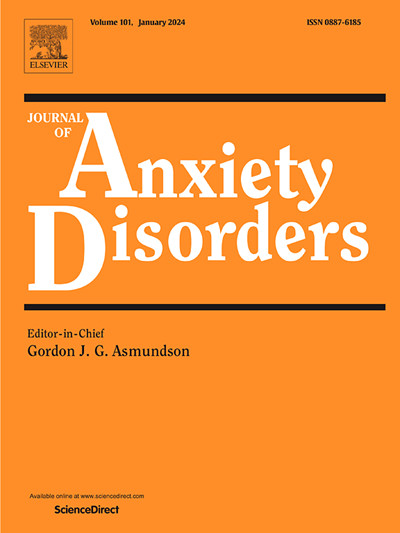Savoring meditation for emotional disorders: Targeting positive emotion regulation deficits
IF 4.5
2区 医学
Q1 PSYCHIATRY
引用次数: 0
Abstract
Deficits in positive emotion regulation (PER) contribute to emotional disorders but are less studied than negative emotion regulation (NER). One maladaptive PER strategy, positive emotion contrast-seeking (PEC-seeking), involves sustaining negative affect to enhance later positive emotions, reinforcing anxiety and depression. This study developed and tested a savoring-based, transdiagnostic intervention to reduce PEC-seeking and alleviate emotional disorder symptoms. A single-blind RCT with 59 Chinese college students with elevated depression and anxiety (majority meeting depression criteria) compared a two-week group savoring meditation intervention to waitlist control. Changes in depression, anxiety, savoring beliefs, and PEC-seeking were assessed at Baseline (T0), MidTest (T1), PostTest (T2), and one-month Follow-up (T3). The experimental group also reported positive and negative affect before and after each group session and individual practice. Savoring meditation significantly reduced depression (T1, d = −1.11, p = .005; T2, d = −1.60, p < .001) with effects maintained at follow-up (T3, p < .001). Negative affect also declined significantly (Session 5, p < .001), though changes in positive affect were not statistically significant. The intervention increased savoring beliefs (T1, d = 1.42, T2, d = 1.41, ps =.003) and reduced PEC-seeking (T1, d = −0.92, p = .027), which in turn mediated reductions in depression. Although anxiety symptoms declined within the experimental group over time, between-group differences did not reach statistical significance. Nonetheless, the effect size was larger for the experimental group (T2, d = 0.34) than for the waitlist group (d = 0.01), suggesting a potential anxiolytic effect of the intervention. These findings suggest that targeting maladaptive PER strategies, especially PEC-seeking, via savoring meditation may effectively reduce emotional disorder symptoms. This study highlights PER’s role in transdiagnostic interventions and provides novel insights into PER-focused therapies.
情绪障碍的品味冥想:针对积极情绪调节缺陷
积极情绪调节缺陷是导致情绪障碍的原因之一,但研究较少。一种适应不良的PER策略,积极情绪对比寻求(PEC-seeking),包括维持消极情绪以增强后来的积极情绪,强化焦虑和抑郁。本研究开发并测试了一种基于味觉的跨诊断干预,以减少寻求pec和缓解情绪障碍症状。一项对59名抑郁和焦虑程度较高的中国大学生(大多数符合抑郁标准)进行的单盲随机对照试验将两周的冥想干预组与候补组进行了比较。在基线(T0)、测试中(T1)、测试后(T2)和一个月随访(T3)时评估抑郁、焦虑、品味信念和pec寻求的变化。实验组也报告了每次小组练习前后和个人练习的积极和消极影响。品味冥想显著减少抑郁(T1, d = - 1.11, p = .005;T2, d = - 1.60, p <; .001),随访时效果维持(T3, p <; .001)。消极情绪也显著下降(第5期,p <; .001),尽管积极情绪的变化没有统计学意义。干预增加了品味信念(T1, d = 1.42, T2, d = 1.41, ps = 0.003),减少了寻找pecc (T1, d = - 0.92, p = .027),这反过来又介导了抑郁的减少。随着时间的推移,实验组的焦虑症状有所下降,但组间差异无统计学意义。尽管如此,实验组的效应量(T2, d = 0.34)大于等候名单组(d = 0.01),表明干预可能具有抗焦虑作用。这些发现表明,通过品味冥想,针对适应不良的PER策略,特别是寻求pec,可能有效地减少情绪障碍症状。这项研究强调了PER在跨诊断干预中的作用,并为PER重点治疗提供了新的见解。
本文章由计算机程序翻译,如有差异,请以英文原文为准。
求助全文
约1分钟内获得全文
求助全文
来源期刊

Journal of Anxiety Disorders
Multiple-
CiteScore
16.60
自引率
2.90%
发文量
95
期刊介绍:
The Journal of Anxiety Disorders is an interdisciplinary journal that publishes research papers on all aspects of anxiety disorders for individuals of all age groups, including children, adolescents, adults, and the elderly. Manuscripts that focus on disorders previously classified as anxiety disorders such as obsessive-compulsive disorder and posttraumatic stress disorder, as well as the new category of illness anxiety disorder, are also within the scope of the journal. The research areas of focus include traditional, behavioral, cognitive, and biological assessment; diagnosis and classification; psychosocial and psychopharmacological treatment; genetics; epidemiology; and prevention. The journal welcomes theoretical and review articles that significantly contribute to current knowledge in the field. It is abstracted and indexed in various databases such as Elsevier, BIOBASE, PubMed/Medline, PsycINFO, BIOSIS Citation Index, BRS Data, Current Contents - Social & Behavioral Sciences, Pascal Francis, Scopus, and Google Scholar.
 求助内容:
求助内容: 应助结果提醒方式:
应助结果提醒方式:


